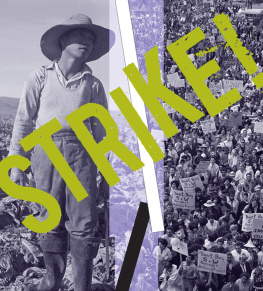PREFACE AND ACKNOWLEDGMENTS
This is the first history of Southern California that links the experience of L.A.'s working men and women to the city's political history, to the occupations and lifestyles of its working-class neighborhoods, and to the complex social, economic, and cultural relationships that developed between the business community and the working class. By including catchment areas to the north, south, and east of the metropolis, it also casts its net more widely than most previous histories of the region.
The book begins in 1880, when Los Angeles was a tiny frontier town and its labor movement was insignificant. It ends in 2010, when the unions in the (now huge) city were doing quite well, but when the future of organized labor in the rest of the country was in doubt. In the 1990s and early 2000s Southern California's immigrant-based unions, such as SEIU, with its organizing campaigns among service workers, appeared to have halted the decline of the local labor movementa development that ran counter to labor's ongoing decline in the rest of the country. But the long-term consequences of these organizing campaigns remain unclear. Will they bring the hope of a recovering labor movement to workers in Los Angelesand perhaps to workers elsewhere in the nation? Or do they merely represent a temporary reprieve in a period of terminal decline?
As of this writing, the latter outcome seems to be more likely than the former. Until recently, the AFL-CIO's dramatic loss of support in the private sector of the economy was to some extent counterbalanced by its success among teachers, health care workers, and other government employees. But the recent recession and attacks on public sector unions have made the preservation and expansion of these successes less certain.
No one can predict the future. But even if the future of unionism in the United States looks dubious, the story that follows should nonetheless appeal to readers with a general interest in American social and economic history. This is because the narrative deals not only with unions but also with the present (and perhaps the future) problems facing the California working class as a whole. Los Angeles occupies an important niche on the Pacific Rim of the global economy. It is the biggest recipient of immigrant workers, and it remains on the cutting edge of technological change. Hence the fortunes of its workersblue-collar and white-collar, male and female, immigrant and native-bornare intimately connected to the fortunes of workers elsewhere in the country.
The chapters that follow discuss labor politics, immigrant and nativist movements, race and gender issues, and the reactions of L.A.'s working-class families to periods of prosperity and recession as well as war and peace. Despite important differences, most of the issues are similar to those faced by workers throughout the country.
The narrative also assesses some of the historical advantages and disadvantages of migrating to the Great Metropolis of the West. This book does not deny the many advantages of living in Southern California. But it offers a counter narrative, based on new research, to those who too easily accept the dominant interpretation of Southern California's past as an unending story of prosperity, leisure, and material success.

I first considered writing this book in the 1980s, when I served on the board of the Southern California Library, a small private repository on Vermont Avenue in South Los Angeles, which specializes in labor and radical history. My thanks go first to my old friends Sarah Cooper, Mary Tyler, and others at SCL who introduced me to its holdings. My writing was also encouraged by discussions with students in my history seminars at UCLA, and especially by my conversations with Jeff Stansbury, a talented labor organizer and journalist, who completed an excellent doctoral dissertation on L.A. labor history in 2008 but diedsadly and prematurelysoon after.
I am grateful, too, to the UCLA Institute for Research on Labor and Employment for two grants that enabled me to conduct research, and to my research assistants David Struthers and Anton Cheremukhin for their fieldwork. Numerous other colleagues and friends in the academic community, as well as inside and outside the labor movement, led me to new sources, made valuable suggestions, and read early drafts of the text. I should particularly like to thank the following individuals for their advice and assistance: Lenny Potash, Peter Olney, Goetz Wolff, Devra Weber, Mike Davis, Phil Ethington, Nelson Lichtenstein, Harold Meyerson, Michael Laslett, Sarah Laslett, Allen J. Scott, Edward Soja, Roger Waldinger, Ruth Milkman, Kent Wong, Becky Nicolaides, Steve Ross, Jan Reiff, and Eric Avila.
Thanks are also owed to the participants in the Los Angeles History Seminars, held at the Autry National Center of the American West and at the Huntington Library, for suggestions they made when I presented papers there. The same goes for my friends in the Los Angeles Study Group on Social History, who read and improved several chapters of this book. I am grateful, too, for help from the staff at various libraries and research repositories, including those at Berkeley, Stanford, Claremont Graduate School, the California State University campuses at Northridge and at Long Beach, San Francisco State University, the Huntington Library, and the Walter P. Reuther Library in Detroit. Denis Deriev was extremely helpful in preparing the manuscript for publication.
I benefited greatly from the advice of Niels Hooper, history editor at the University of California Press, and from the editing skills of Kim Hogeland, Rose Vekony, and Mary Renaud. I also would like to thank the staff at the Charles E. Young Research Library for their help and the employees of the History Department's Computer Center for their unfailing kindness and assistance.








